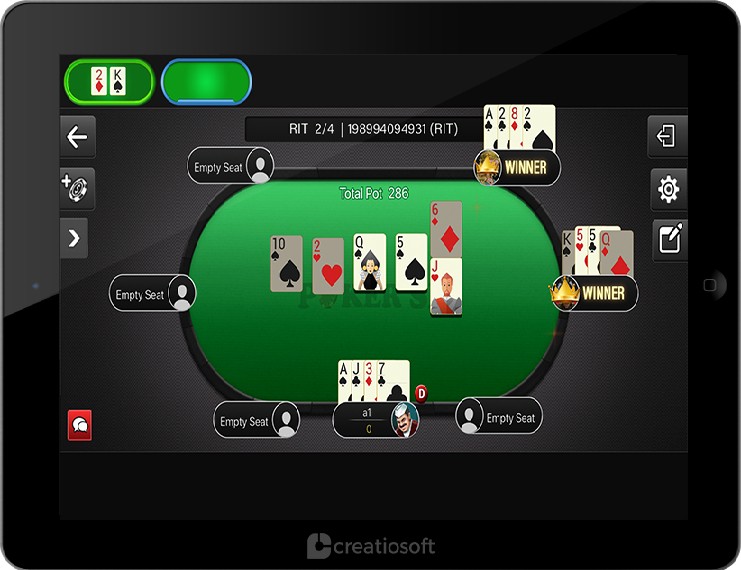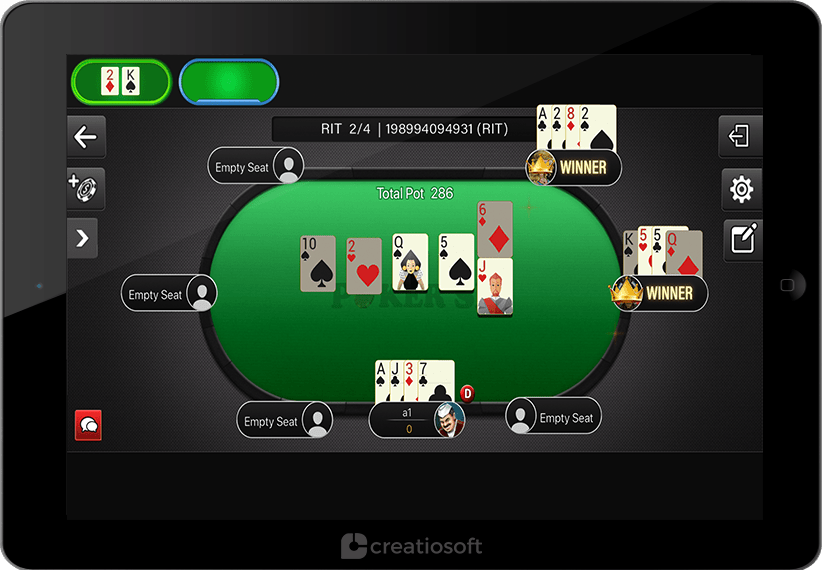Poker is a famous card game that has grabbed the hearts and minds of millions of players worldwide. It is a game of skill and strategy. In poker game software, participants must make calculated judgments based on insufficient information. Creating a winning poker game requires a thorough grasp of the game’s fundamentals.
This article will outline the key elements and challenges in building a profitable poker game. We will begin by explaining the significance of knowing the game’s fundamental mechanics. These include rules and mechanics, security, user interface, artificial intelligence and licensing.
While developing a poker game, developers must balance the game’s complexity and accessibility. They must ensure fairness and security. They must attract and keep players in a competitive industry. You can consider these factors to hire poker developers for your game development purpose.
Now that we’ve presented the concept, let’s go further and evaluate the key elements and challenges for developing the poker game.
Key Elements of Developing a Winning Poker Game
Creating a good poker game involves carefully considering all major factors. These range from the rules and mechanics to the visuals and sound effects, security, and marketing. By paying attention to these factors, poker game software developers may design an interesting and pleasant game that will appeal to many players.
Below is a list of some of the crucial components that must be present in a poker game:
Rules and Mechanics:
The rules and mechanics of a poker game serve as the game’s basis. The rules and mechanics must be created to guarantee that the game is fair, interesting, and entertaining for all participants. Players, game setup, betting rounds, hand rankings, betting limits, and ties are some of the rules and mechanics of a typical poker game.
Poker game software developers should ensure balanced game mechanisms. They must check that there are no loopholes that players might use to get an unfair advantage. Clear and consistent rules and mechanisms make the game more entertaining for participants. It prevents cheating and protects the game’s integrity.
Game Variations:
Poker has a long history and has developed into several varieties. The poker game solutions provider uses these variants to enhance the game’s intensity and depth, keeping players interested and entertained. Each poker variation has its own set of rules, mechanics, and techniques that contribute to the game’s complexity. Texas Hold’em is the most popular poker game. Although many other games, such as Omaha, Seven-Card Stud, Razz, Five-Card Draw, and Caribbean Stud, are also available.
While choosing a poker variation to include in a game, game creators must consider the audience they want to attract. They must guarantee that the rules and mechanics of the chosen variant have been executed to deliver a compelling game experience for their players. By adding many poker game versions, Poker game software developers may attract a wide collection of players. The players may have varying skill levels and preferences. Ultimately, game variants are critical to the sustainability of poker and keep the game fresh and intriguing for both new and seasoned players.
User Interface:
A poker game’s user interface (UI) is vital to the gaming experience. It includes all the visual and interactive aspects that a player sees and interacts with on their screen. This includes the game lobby, table layout, betting choices, and cards.
Usability is an important aspect of a poker game’s UI. The interface must be intuitive, responsive, and simple to use. This makes the players focus on the game rather than figuring out how to utilize the interface. The user interface must also provide simple and understandable information to players about their hands, the community cards, and the game’s condition.
Artificial Intelligence:
Artificial intelligence (AI) is a vital element in modern poker games. AI may be utilized to generate realistic and tough opponents for single-player games. AI provides complex features like hand analysis and player monitoring and prevents cheating. Poker game software developers must carefully assess the usage of AI in their poker games. It ensures the improvement of the overall gaming experience and supports fair play.
AI provides sophisticated features such as hand analysis and player tracking. Hand analysis tools employ AI algorithms to evaluate players’ hands. It also provides insights into their strengths and shortcomings. It is used in player monitoring systems to assess players’ behaviour and provide insights into their playing style. This allows players to make better-informed decisions during games.
Multiplayer Support:
Multiplayer support enables players to compete against each other online, providing a social and competitive element to the game. Multiplayer support is often provided via an online matchmaking system. In this, users are paired with opponents of comparable skill levels or preferences.
To provide a pleasant multiplayer experience, poker game software developers consider the variables like server architecture, matchmaking algorithms, and anti-cheating techniques. To manage the potentially enormous number of players and deliver a consistent and lag-free gaming experience, server architecture must be strong and scalable. Matching algorithms must be built to provide fair and balanced matches. The matches are based on skill level, player preferences, and other parameters.
Multiplayer support necessitates social elements such as chat functionality, player profiles, and leaderboards. These features allow players to connect, track progress, and compete for awards. It also adds a social and competitive element to the game.
Graphics and Sound:
Graphics and sound are important components of a poker game’s user interface. They contribute to a more immersive and interesting gaming experience. Players should find the visual design and sound effects of excellent quality, authentic, and enticing. It must provide players with audible feedback. Ambient sound and music should create a realistic and immersive environment.
A poker game’s graphic design should be clear, uncomplicated, and simple. Poker game software developers must employ high-quality visuals to generate realistic card designs, table layouts, and animations. The graphic components should be constant throughout the game to provide a unified and professional image. Lighting and shadows also contribute to a more immersive environment.
Sound effects are very important in creating a realistic game environment. Sound effects, such as the sound of moving chips or dealing of cards, should be timed with the gameplay. It provides auditory feedback to players about their actions. Ambient noises, such as music or background noise, may also be used by developers to create a more immersive environment.
Security:
Security is an important feature of any online poker game. Players leave their personal and financial information on the game’s servers. To secure gamers’ data and prevent unwanted access or cheating, poker game software developers must include strict security measures.
Here are some methods you can take to increase poker security:
● Encryption:
All data exchanged between the client and server should be secured using safe encryption technologies. This covers user login, gaming, and money transactions.
● Authentication:
User authentication should be performed to guarantee that only authorized users can access the game. The technique used should be safe and trustworthy, such as two-factor authentication.
● Random Number Generation:
The random number generator (RNG) utilized in the game must be really random and unexpected. An impartial third party should test and certify the RNG to ensure its fairness.
● Anti-Cheating Measures:
The game should have anti-cheating features. This includes recognizing and blocking unusual patterns of behaviour, detecting multiple accounts and detecting and prohibiting the usage of bots.
● Secure Payment Processing:
The payment processing system must have strong encryption and fraud detection systems if the game involves real money. It assures dependability and security.
● User Privacy:
Gamers’ personal information should be safeguarded, with tight procedures governing data storage, access, and sharing.
Payment Systems:
Game players want a safe and dependable method for depositing and withdrawing earnings from their accounts. Here, the payment procedures of an online poker game come into action. To ease out the process, poker game software developers must create payment methods that are simple to use, reliable, and secure.
Credit cards, debit cards, e-wallets, and bank transfers are the most often utilized payment methods in online poker games. These payment mechanisms should be smoothly incorporated into the game’s user interface. It allows players to make deposits and withdrawals easily.
In addition to payment mechanisms, developers may integrate loyalty programs or incentive systems. These programs entice players to make deposits and continue playing. It may feature bonuses, cashback offers, or other incentives to reward players for loyalty.
Licensing:
The licensing procedure begins with applying to the gaming authority. It includes information on the game’s ownership, financial status, and security measures. The gaming authority assesses the application. It then undertakes background checks on the developers and their partners. Finally, they verify that the poker game software developers are respectable and trustworthy.
When the license is obtained, the gaming authority monitors the game. This is done to ensure it conforms with legislation and industry standards. This includes frequent audits of the game’s security systems, payment systems, and player data protection procedures.
The licensing process assures participants that the game is fair and operates with integrity. It also gives developers the authority to run an online poker game in a competitive market. This draws more players and raises income.
Marketing and Promotion:
The developer must have a strong marketing and promotion plan to attract gamers. One successful marketing method is to utilize social media channels. You can advertise the game and connect with potential players. This includes building social media profiles for the game, uploading updates and news, and connecting with players via comments and direct messaging.
Advertising should be tailored to certain demographics and geographic areas. It guarantees that the poker game software reaches its intended audience. Besides advertising, developers can create referral schemes or affiliate programs. These programs encourage players to suggest their friends and family to the game. These can include financial bonuses or other benefits for successful referrals.
Now that we’ve covered the key elements of poker game development let’s look at the challenges that come with it.
 Challenges in Developing a Winning Poker Game
Challenges in Developing a Winning Poker Game
Developing a poker game has various challenges. It ranges from legal and regulatory compliance to complicated game mechanics and robust security and payment processing requirements. The poker game software developers must know these issues and get the solutions.
Here are some of the major challenges that game developers may encounter while designing a poker game:
Legal and Regulatory Challenges:
Developing a poker game has legal and regulatory concerns. These must be addressed to guarantee compliance with industry norms and standards. Online poker is regulated in many areas. To lawfully run the game, poker game software developers must receive a valid license from a recognized gaming body.
The complexity of Game Mechanics:
Poker is a complex game with various versions, and poker game software developers must determine which form of poker to include in the game. They must verify that the game mechanisms are precise, consistent, and balanced, which can be difficult.
Artificial Intelligence:
Creating a challenging and realistic AI opponent for the game’s single-player mode might be tough. The AI needs to adjust to the player’s skill level. This makes the game demanding but not too difficult and delivers a compelling gaming experience.
Multiplayer Support:
Adding multiplayer functionality can be difficult. It is due to the necessity for safe and dependable network access. Also, anti-cheating procedures and server infrastructure management are part of it. Creating successful matching algorithms and maintaining lobbies and chat systems may be tough.
Security:
Internet gaming is an appealing target for hackers and fraudsters, making security a top priority. Poker game software developers must use robust security techniques to protect players’ personal and financial information. These include encryption, secure authentication, and fraud detection.
Payment Processing:
Creating safe and dependable payment processing systems can be difficult. The developers must interact with different payment providers. They also guarantee that all transactions are secure and regulatory compliant.
User Experience:
Developing an engaging and immersive user experience may be difficult. Developers must balance between different functionalities. These are visual and audio effects, animations, and game mechanics. All of them produce a pleasant gaming experience. This can be exacerbated further by the need to optimize for multiple platforms, such as desktop and mobile devices.
Final Thoughts
Creating a successful poker game software necessitates a thorough awareness of the key elements at play and the challenges that must be addressed. Developers must prepare and execute each game component, whether it’s game mechanics and rules or its user interface, artificial intelligence, and security. All these help to create a fun and engaging experience for players.
The challenges of establishing a poker game are numerous. It includes compliance with legal and regulatory standards, and balancing complexity and accessibility. It also maintains fairness and security attracts. Along with that, it keeps players in a competitive market. To stay ahead of the competition and give gamers a cutting-edge gaming experience, developers must keep up with the newest trends and technologies.
Frequently Asked Questions
Q: What key elements do you use to develop a poker game?
A: The key elements we use to develop a poker game entail developing a game concept, rules, user interface and user experience. We also use the integration essential components. These integrations are multiplayer functionality, AI opponents, and secure payment systems.
Q: What are some of your biggest challenges in developing a poker game?
A: Some of the challenges we face while producing a poker game include establishing a fair and balanced game with realistic gaming mechanics, providing an intuitive user interface, integrating secure payment systems and anti-cheat methods, and generating clever AI opponents.
Q: How do you ensure the security of payment systems in a poker game?
A: To safeguard user data and maintain the security of payment systems in a poker game, we employ trustworthy payment gateways and SSL encryption. Anti-fraud procedures should also be implemented to avoid fraudulent transactions and chargebacks.
Q: Can you develop a poker game without using AI opponents?
A: Yes, we can create a poker game without employing AI opponents. However, introducing AI opponents can increase the game’s replay value and provide a challenge for players who do not have other human opponents to play against.
Q: How can you make a poker game stand out from other poker games on the market?
A: We work on establishing a distinctive game idea. We also implement creative gaming mechanics and offer an amazing user experience with high-quality visuals and sound design. All this differentiates our poker game from others on the market. Social elements like leaderboards and player profiles also boost engagement and retention.
















